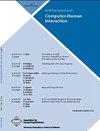可用性测试中的同步或回顾性朗读思考?元分析综述
IF 4.8
2区 计算机科学
Q1 COMPUTER SCIENCE, CYBERNETICS
引用次数: 0
摘要
在可用性测试中,通常会要求用户大声思考,让评估者倾听他们的想法。这种方法有两种变体,一种是让用户在使用被测产品时大声思考(同时大声思考,CTA),另一种是在使用后大声思考(回顾性大声思考,RTA)。本研究回顾了对 CTA 和 RTA 进行比较的研究,以探讨在可用性测试中使用这两种方法的得失。共有 29 项研究(报告了 42 项 CTA 和 RTA 的比较)符合纳入标准,并被纳入荟萃分析。两者的主要区别在于,CTA 的任务时间更长,但总时间更短,而 RTA 的用户口头解释、问题表述和设计建议更多。此外,与 RTA 用户相比,CTA 用户可能认为评估员的存在对他们的干扰较少。本文章由计算机程序翻译,如有差异,请以英文原文为准。
Concurrent or Retrospective Thinking Aloud in Usability Tests? A Meta-Analytic Review
In usability tests, the users are commonly asked to think aloud to let the evaluator listen in on their thoughts. Two variants of this procedure involve that the users either think aloud while using the tested product (concurrent thinking aloud, CTA) or after using it (retrospective thinking aloud, RTA). This study reviews the studies that compare CTA and RTA to investigate what is gained and lost by using one or the other variant in a usability test. A total of 29 studies, reporting from 42 comparisons of CTA and RTA, matched the inclusion criteria and were included in the meta-analyses. The main differences are that for CTA task time is longer, but total time shorter, whereas for RTA the users verbalize more explanations, problem formulations, and design recommendations. In addition, CTA users probably experience the evaluator’s presence as less disturbing than RTA users do.
求助全文
通过发布文献求助,成功后即可免费获取论文全文。
去求助
来源期刊

ACM Transactions on Computer-Human Interaction
工程技术-计算机:控制论
CiteScore
8.50
自引率
5.40%
发文量
94
审稿时长
>12 weeks
期刊介绍:
This ACM Transaction seeks to be the premier archival journal in the multidisciplinary field of human-computer interaction. Since its first issue in March 1994, it has presented work of the highest scientific quality that contributes to the practice in the present and future. The primary emphasis is on results of broad application, but the journal considers original work focused on specific domains, on special requirements, on ethical issues -- the full range of design, development, and use of interactive systems.
 求助内容:
求助内容: 应助结果提醒方式:
应助结果提醒方式:


